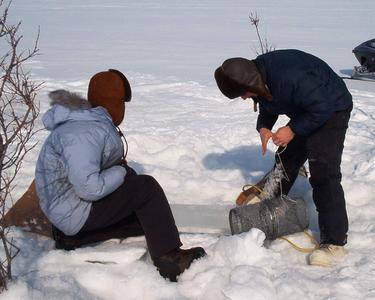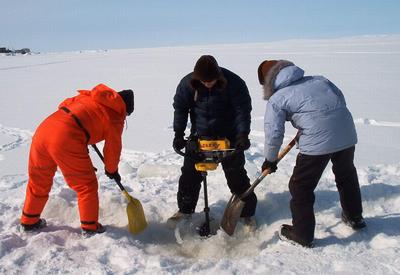20 April, 2003
First Trip on the Ice
Today in Kotzebue
A temperature of 7 degrees met us as we left the house we are
sharing. The skies are crystal clear and brisk. I can see across the
sound to the mountains on the other side. They look very close, but
looks can be deceiving.
What science is happening?
Today we went out to sampling site T405 out on the ice over the
Kotzebue sound. The first order of business was to drill a hole with a
special auger that saves the ice core. We are looking for the algae at
the bottom of the core, but today we are out of luck. The ice is clear
to the end. The weather is not warm enough to have algae yet, however
that is a new piece of information that we need to continue.
We finish with the large auger and make two drill holes. We were
going to drop a piece of equipment called a CTD diver. As we have been
working we have had a lot of company from local residents and have
decided that this expensive piece of equipment would not be secure at
this busy location.
We did put some traps out to see which animals are active at this
location at this time of the year. Tomorrow we will do some other
tests, here, but for today we have stirred the water column up too much
with our drilling to get accurate results.
Classroom Connections:
After we finished our work for the day, it was decided that I should
get some experience driving the snow machine. We zipped across the
Kotzebue sound. With the mountains in view, the other side appeared to
be relatively close, but that was an illusion. Actually, it was 16
miles travel on a highway marked only by willow shrub branches. We
explored the country, bluffs and outlying camps for several hours and
then zipped back. I was pronounced a snow machine expert.
.
Questions:
1.) If I traveled on my snow machine at 42 mph and
went 16 miles across the sound, how long did it take me to get there
and back?
2.) We saw many caribou tracks (and 4 caribou) and some
recent brown bear prints. What do you surmise has happened recently?
Words to know
CTD Diver- This piece of equipment test
Conductivity (the amount of saline or salt in the water)
Temperature and Depth of the water.
Reflections
To be involved with
scientists is very different that one might suppose. I assumed that I
would need to be very formal and focused and serious to be considered a
part of the team, but the one thing I am trying to get my students to
understand is the one thing that I have come to understand myself, that
scientists are just people. Iím having a wonderful time, Iím working
hard but Iím also making good friends with some good people.
Links
Learn
more about our project here
View curriculum for this project, ďAsk a ScientistĒ and
learn about other Arctic Real Time research at Arctic Alive
City of
Kotzebue Webpage
Listen to the local radio station KOTZ live

Terry and Melinda Renoylds are aurgering an ice core. This auger will pull up a core of ice. Lisa is looking for algae at the bottom of the core but there is not enough sun light at this time of the year to grow algae so we were dissappointed today.

After all the holes are drilled, the ice is measured (118 cm), and traps are layed to see what species are present at this time of year.

Terry and Melinda Renoylds are aurgering an ice core. This auger will pull up a core of ice. Lisa is looking for algae at the bottom of the core but there is not enough sun light at this time of the year to grow algae so we were dissappointed today.
Contact the TEA in the field at
.
If you cannot connect through your browser, copy the
TEA's e-mail address in the "To:" line of
your favorite e-mail package.
|







